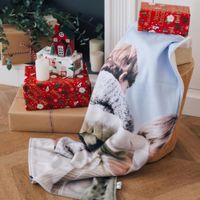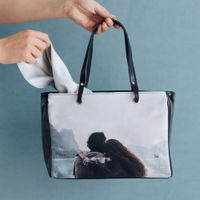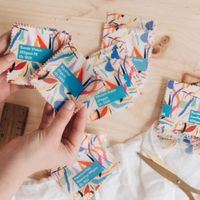-
Can you print on my own fabric?

We used to offered this option however it has now been discontinued.
-
Colour Profiles and Pantones
![]()
We advise providing images in the RGB colour space. Specifically using the sRGB image profile, to achieve best colour results.What does this mean? In your editing software choose RGB as the working space, and assign the image profile as sRGB (full name sRGB IEC61966-2.1)
PANTONES should be referenced from
the “pantone textile colour libraries”. The pantone “coated and uncoated”
colour mixes are intended for laser and lithographic printing which are not
suitable for textile printing. Pantones should be created within a CMYK colour
space. Whilst we try to closely match pantone, due to the nature of our
printing an exact match is not always possible. If an exact pantone match is
essential please contact us prior to ordering.
MONITORS VS PRINT
Keep in mind that only specialist graphic
monitors under strict lighting conditions will be able to reproduce printed
colours. Your average laptop or PC screen will look great, but will not
necessarily be accurate and a lot of the colours are so bright that printers
cannot reproduce them. For further reading search for “subtractive colour vs
additive colour” to understand the limitations of colours on monitors and
printed media.
COLOUR CONTINUITY
If you place repeat orders remember
to keep your colour space and profiles consistent. If you upload a graphic as
rgb and then order again with a cmyk profile there will be a difference in the
way our printers translate the colours, resulting in different perceived
colours on the finished item.
BLACK AND WHITE
To get best neutral black and white
we advise uploading your file as a greyscale file.
You can only upload PNG, JPG and flattened TIFF files. If you upload unflattened tiffs this will cause unintended changes to your design (not visible in our preview) and for which we cannot cover liability.
-
Prepare your designs
![]()
Our design interface will accurately enough advise whether your uploaded design is of sufficient quality to print at the physical size you selected.
Do make sure to only upload JPG, PNG or flattened TIFF files. Uploading unflattened
tiffs can cause unintended changes to your design, which you will not see in
our preview and for which we cannot cannot accept liability.
On the design interface, if you see an orange low quality warning you have a few options to ensure your print is as sharp as possible:
- Reduce the size of your graphic as well as tile. You could reduce the size of your image until the LQ warning is gone, then use our variety of tiling options to fill the whole print area.
- Reduce the size of your images and potentially add a background colour. Again reduce your graphic size until the LQ warning goes away.
- Using software to upscale.
WORD OF CAUTION: this can also further reduce the quality of your design, and should be used as a last resort only. Recapturing the original image at a much higher resolution is best practice if at all possible. Do not simply increase the dpi/resolution of a file as it will only confuse online systems into believing the updated image ise of good quality when it actually still is not.
Use the image size dialogue in Photoshop or any other design tool and you can re-sample your design/graphic/image via Preserve Details (enlargement) or Bicubic Smoother (enlargement) > then do increase the resolution or width/height.
Resampling your image also means that what was originally one pixel is enlarged into many more. This will increase the size of your graphic (in terms of file size, physical size and resolution) but will not necessarily increase the actual quality, and straight lines as well as fine details can become fuzzy. Careful sharpening after enlarging can bring detail back into focus.
Photoshop plugins such as “Real Fractals” can do a better job of enlarging, there are many more available for a small fee or free of charge.
If your graphic is simple enough (low details, low number of colours) you can import into a tool like Adobe Illustrator and use its image trace preview, playing around with the settings to get an accurate trace of your image.
Always export your image at max quality, using formats such as tiff or PSD when editing, and only saving to a jpeg when you are uploading your file for print.
-
Grain direction of the fabrics

This information is intended for designers and is only about fabric printing.
Grain runs across the width of the roll on all our fabrics.
In case grain direction is important to you, this means that when creating your design on the design interface and after selecting your own dimensions in the "Product Options", you need to make sure that you add and position your file(s) on the design interface keeping in mind that the grain direction will be running across the width of the design interface (= width of the fabric)
For your information, we print your artwork in the orientation that you design in our online preview. Imagine the preview is a roll of fabric running from top to bottom, the width of the roll is left to right.
This is especially important for fabric destined to become clothing as the stretch on our jerseys runs across the width of the roll. If you make the width wider than the fabric selected we rotate by 90° in order to fit it on the roll.
-
Cutting and Hemming Options
![]()
We offer four finishing options for fabric orders:
As it comes: We cut around your image, leaving an uneven white fabric border.
Hem with thread: We can hem your fabric with black or white thread, which affects the print size.
Cut on the line: We cut neatly on the edge of your image.
Hemming options are available for a small fee, either a folded hem (single or two-fold) or an overlock hem in black or white thread. Some fabrics work better with one type of hem, and a suitable option will be provided. Hemming will reduce the finished piece size, so adjust your print size accordingly.
Average fabric shrinkages by type are as follows:
Light Fabrics and silks: 6-8mm 2-fold hem, minus 12-16mm per side.
Medium Fraying Fabrics: 15-20mm 2-fold hem, minus 35-40mm per side.
Stiff, Heavy, & Non-Fraying Fabrics: 15-20mm 1-fold hem, minus 15-20mm per side.
Please consider these approximate shrinkage values (2-8%) along with your chosen hemming options.
-
Order Fabric and Transfer paper?
![]()
On each product page (fabrics and transfer paper included):
- select "Start Design" or "Add to cart" and you will be presented with our order interface
- Choose your fabric
- Select the length and width of paper / fabric needed and update the dimensions.
- Keep in mind that the design interface will change shape to match the length and width selected and allow you to design.
- If you require extra white fabric around your design, make sure to allow for this extra space within the dimensions selected. We do not provide extra fabric outside of the selected dimensions.
- It is set to 5m length - but you can make quantity selection to get larger runs
Please click here to access:
-
Can the fabrics be ironed?
![]()
Our fabrics can indeed be ironed at a low heat. 100% Silk needs to be ironed at a very low heat and 100% Cotton can be ironed at a medium heat.
-
Unit of measurements
![]()
Momme:
Mm is a special
unit of measurement used for silks only. Mm means “Momme
weight” (not millimetres)
It is a unit
measurement seldom used nowadays referring to how much a full width x 100 yards piece of silk
weighs. Momme weight basically represents 100 yards of silk long by 45 inches wide, in pounds. If a fabric has a
momme weight of 8mm, it means that 100 yards of the fabric weighs 8
pounds. Silk scarves and dresses will be 8mm in weight on average. Higher quality silks would be between 14-16mm. Silk beddings would be heavier at roughly 19mm or 19 pounds in weight per 100 yards.
-
Help! I am a student

If you are a UK student, you can receive 40% discount on Fabrics (terms and conditions apply). The discount for students located outside of the UK is 20% (minimum cart value €/$30). Here is how to redeem the discount:
- Create an account and select the student tab.
- Complete the fields
- Enter your name
- Upload your document that proves you're a student
- Let us know the name of the institute you're a student at
- Tell us how long your proof is valid for
- We will then look at the information that you have sent us (we aim to do so within 1 to 2 working days)
- If everything is all fine, we will approve your application and you will be able to access your student discount as long as you are logged in
- If we need any more information or your registration is rejected, we will let you know within this tab (remember your proof of eligibility needs to be dated)
For your information, if you wish to order
Fabric samples, if you add more than one sample to your cart, the cost falls dramatically, and is automatically divided by almost two.
We are very fast in our production and have saved many student projects with our speedy turnaround of 1 - 2 days - same day in some cases if ordered before midday Monday to Friday.
Please note that you will only be able to have either a wholesale account or a student account. Applying for the other will cancel the one that you already have.







